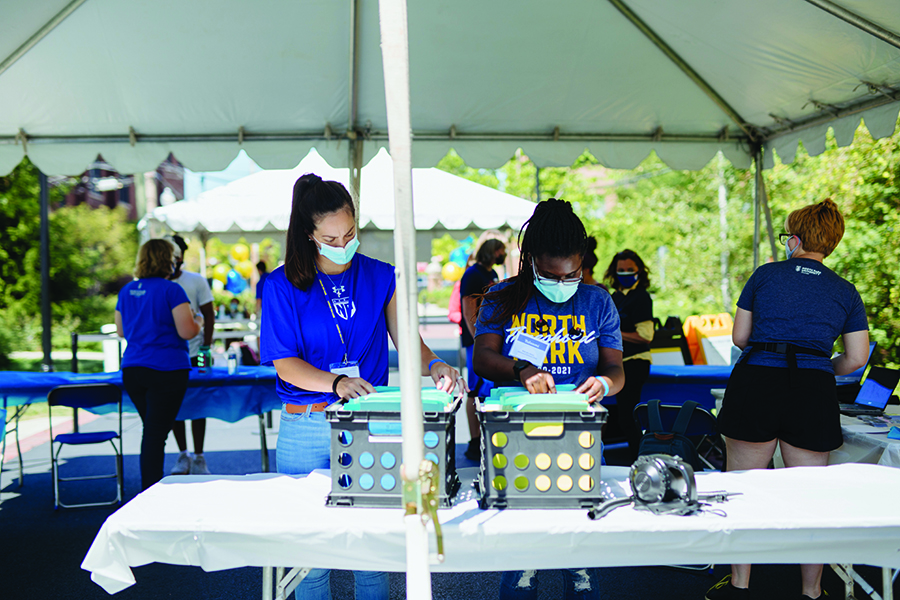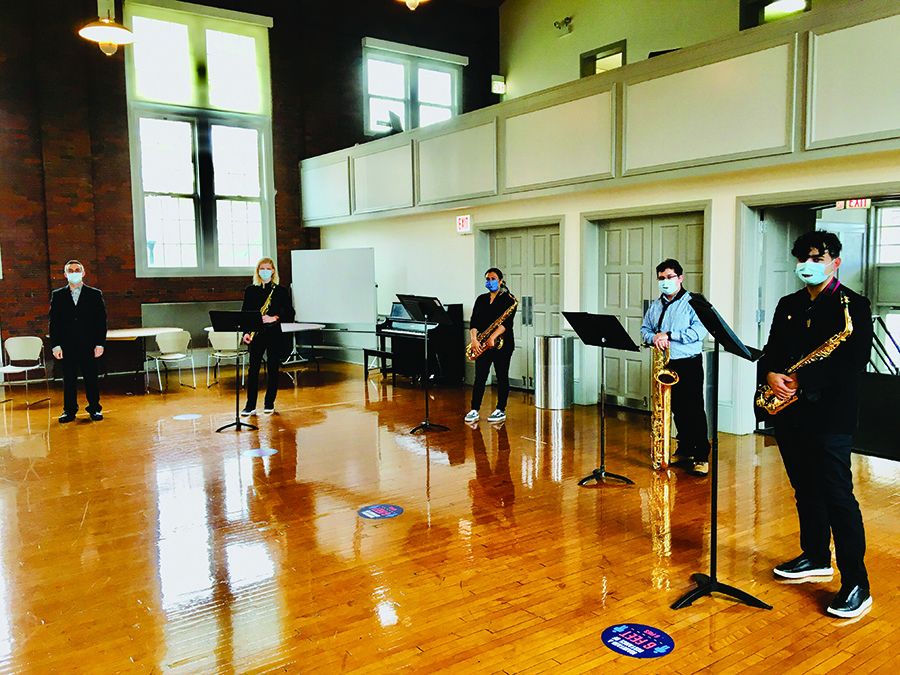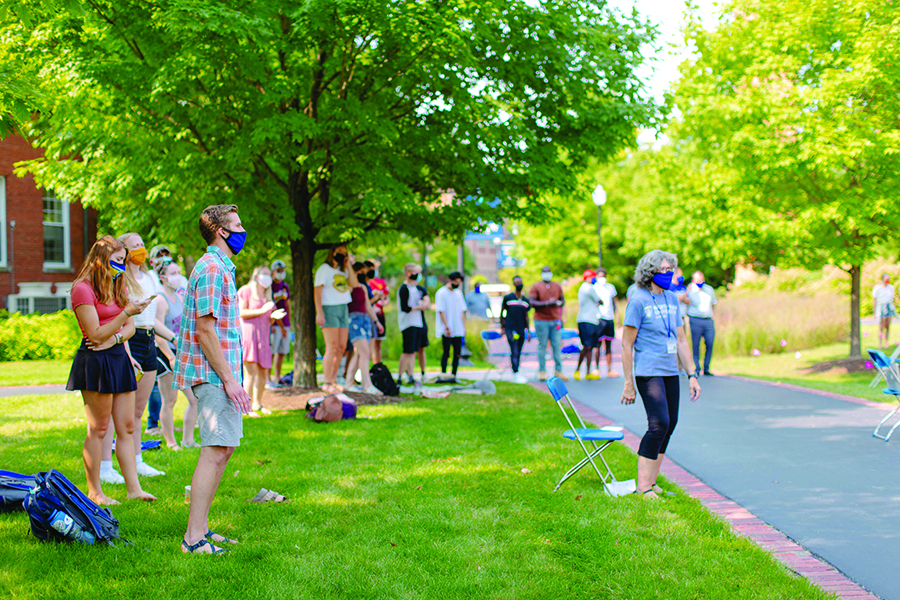
North Park’s campus looked a bit different at the start of the Fall 2020 Semester: Large white tents occupied open green space; new signage indicated where people should walk; and masks were everywhere.
“The past few months have been filled with extraordinary challenges for all of us,” President Surridge said in her welcome remarks to new and returning students. “But I am so proud of the perseverance, resilience, character and strength that our community has shown.”
The fact that campus was able to reopen at all was a credit to the hard work of a dedicated task force of faculty and staff who worked all summer on reopening plans.
Among those plans: rearranging classroom spaces to allow for proper social distancing, stepped-up sanitizing protocols, reduced occupancy in residence halls, surveillance testing, and dedicated space to house quarantined students.
Students, faculty, and staff were required to use a new symptom-checking app, called Campus Clear, before coming to campus each day. They were also asked to sign the Viking Shield, a statement of personal commitment to maintaining established safety protocols.

“We’re all in this together, and we share the responsibility to keep our campus community as safe as possible,” President Surridge said.
Students seemed to adapt well to the “New Normal,” embracing outdoor Chapel services, music rehearsals, and classes. Students enjoyed meals and other socially distant gatherings under the new tents set up strategically across campus.
Professors, too, got creative, tailoring class offerings to fit the times. For instance, when the pandemic first hit, Dr. Drew Rholl, Associate Professor of Biology, and Peter Olfelt, Lecturer in History, teamed up to teach their students about pandemics in a holistic and engaging way.
Advanced Topics in Biology: Pandemics, is taught by Dr. Rholl, while Professor Olfelt teaches Pandemics in History. By sharing resources and information, students in each class can see the true scope of a pandemic as it relates to history and science.
Using data Dr. Rholl and his class generate, Olfelt can better explain to his students the factors in disease transmission and mitigation. Meanwhile, Olfelt’s students provide Dr. Rholl’s Biology class with historical context and the societal implications of a pandemic.
“Dr. Rholl and I came up with the idea of connecting our two courses during the summer,“ Olfelt said. “He reached out to me, and together we worked out how our students could collaborate on a shared project.”
Dr. Rholl said the level of interest and engagement by students is higher than he anticipated.
“It’s really inspiring. Students are really interacting with the content and each other on a deeper level, and that is really rewarding for everyone involved.”
And with in-person concerts, art shows, and theatre off the table, North Parkers had to get creative with performances. “We made good use of the tent outside Hanson that has become part of the campus landscape this fall,” said Dr. Joe Lill, Professor of Music, who held rehearsals in three sections—woodwinds, brass, and percussion—outside. “We were also grateful for the mild autumn weather we experienced!”

Lill’s goal was to record each section separately, and then put them together in a recording in time for North Park’s annual Festival of Lessons and Carols, another tradition that looked different this year. People tuned in from across the country on Facebook and YouTube to watch the modified Lessons and Carols in early December.
Choral students took the opportunity to explore themes of isolation, said Dr. Julia Davids, Stephen J. Hendrickson Professor of Music.
“While safety measures mean we can only sing in person in small groups for short periods of times behind the barriers of our masks and physically distanced, we have reached out to each other through our vulnerability,” Dr. Davids said. “Many of the students have worked collaboratively to communicate their own thoughts about isolation through original compositions and spoken word.”
Student artists used themes of being at home in their work as well. Minnie Fawcett-Tang, for instance, was inspired by one of Covid-19’s biggest byproducts: handwashing.
“The new normal is that we are now spending longer than ever before washing our hands, so in response I created Sink Paintings,” said Fawcett-Tang. “After I painted a sink in my parent’s house (in London), I collected photos by posting about it on my Instagram.”
She has painted 10 of the 23 photos she has received so far.
“Asking for these snaps is both an impersonal thing, but also something that becomes intimate as I spend the time to really look at the spaces. Every sink has the same function, but at the same time they are all slightly different.”
Perhaps no area of college life has felt more upended than athletics, but even there, adaptations have been made.
Helwig Recreation Center, where most student athletes train and work out together, was totally reimagined, with workout equipment spaced apart from one another and temperature checks and masks required before entering. The athletic department got creative by opening an outdoor weight room.
By mid-October, the football team was able to start practicing outdoors, wearing masks and remaining socially distant when possible. Although there is no start date set for fall sports like football, the athletes and their coaches remain hopeful that some games can be played.
Elsewhere on campus, Catalyst hosted a number of virtual events, including book discussions and a discussion about Black Lives Matter with an aunt and uncle of George Floyd Jr.
The semester was a particular challenge to spiritual health, with students, faculty, and staff unable to convene as a group for regular Chapel and CollegeLife events.

Campus Co-Pastors Laura Kraybill and Terence Gadsden spent the semester in a conversation on Ubuntu: Acts 2 Reconcile, in which they examined our relationships with one another. Ubuntu is an African word meaning “humanity to others.”
In one of the last Chapel services of the semester, around Election Day, they discussed Ubuntu in the context of what reconciliation looks like during a time of national division.
In order to heal division, “We have to listen,” Gadsden said during the discussion. “But we also have to move in love and speak the truth in love. And the effort has to be on both sides.”


